When it comes to buying shoes, most people focus on length, but width is just as important for comfort and foot health. Ever thought, “what does EE mean in shoe size?” EE is a designation for extra-wide shoes, designed for people with wide feet, bunions, or swelling issues.
Wearing the wrong width can lead to discomfort, blisters, and even long-term foot problems. Understanding shoe width helps you choose footwear that fits well, feels comfortable, and supports your foot structure.
What Does EE Mean in Shoe Size? Factors to Understand in Wide Shoe Sizing
1. Understanding Shoe Width Labels
Shoe width labels are essential for ensuring comfort, proper fit, and foot health. While most people focus on shoe length, width can significantly affect how a shoe feels throughout the day. Different widths accommodate variations in foot shape, toe space, and overall stability.
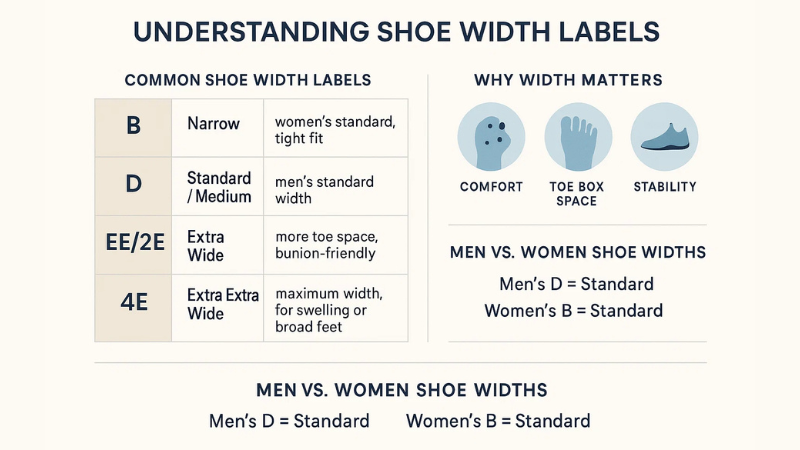
Why Width Matters
Comfort: Shoes that are too narrow can cause blisters on your feet. It can also cause pinching or pressure points, while overly wide shoes may feel loose and reduce stability.
Toe Box Space: Extra width gives room for toes to spread naturally, reducing the risk of bunions and hammertoes. If the toe box is too small, it can cause severe toe pain when you wear it.
Arch Support & Stability: Proper width ensures the foot sits securely in the shoe, enhancing balance and reducing fatigue during long hours of standing or walking.
A shoe with proper width can be very useful if you have flat feet. But finding these types of specialized shoes can be difficult. That’s why we’ve come up with a list of the best shoes for flat feet of this year for your convenience.
Men vs. Women Shoe Widths
Width labels differ between genders:
- Men’s D = standard / medium
- Women’s B = standard / medium
- This means a woman with wide feet may need a D or EE in women’s shoes or convert to men’s sizing for better fit.
Tips for Choosing the Right Width
- Measure your feet at the end of the day when they’re slightly swollen.
- Check brand-specific width charts, as sizing can vary.
- Try shoes with insoles if you need extra arch support or heel stability.
- For online purchases, read reviews for notes on width, especially if you have particularly narrow or wide feet.
2. Difference Between D and EE Shoe Width
Choosing the right shoe width is just as important as selecting the correct length. A mismatch can lead to discomfort, pain, and even long-term foot issues. Two of the most common width labels are D and EE, and understanding their differences helps you pick the perfect fit.
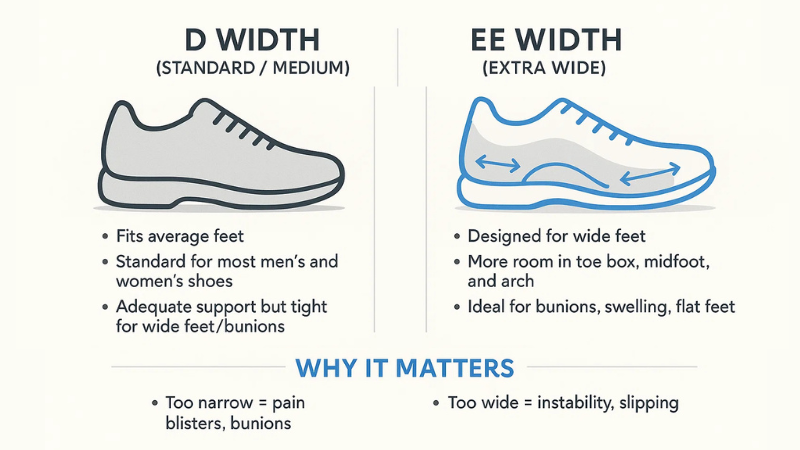
D Width (Standard / Medium)
- Fits average foot sizes comfortably.
- Most shoes on the market are D-width, making it the standard for both men’s and women’s shoes (men’s D = standard, women’s B = standard).
- Suitable for people with normal arch height and average foot volume.
- Provides adequate support but can feel tight for those with wider forefoot, high insteps, or bunions.
EE Width (Extra Wide)
Designed for wider feet, providing additional room in the toe box, midfoot, and arch.
Ideal for:
- Wide feet or naturally broad foot shapes
- People with bunions, flat feet, or plantar issues
- Feet that swell during long hours of standing or walking
Helps distribute pressure evenly, reduces friction, and enhances overall comfort.
Wearing EE shoes can improve posture, balance, and foot alignment, reducing fatigue during extended wear.
Why It Matters
Shoes that are too narrow (e.g., wearing D-width when your foot needs EE) can cause blisters, bunions, arch pain, or numbness.
Conversely, shoes that are too wide may feel loose, causing instability, slipping, and uneven gait.
Correct width ensures your feet can move naturally while remaining supported, which is especially important for professionals who stand or walk for long periods.
Pro Tip
If you’re unsure whether you need D or EE, measure your foot at the widest point and compare it to the brand’s width chart. Many brands provide detailed guides for men’s and women’s widths.
For online shopping, read customer reviews that mention fit and width.
3. Shoe Width Chart Explained
Shoe width is just as important as length for comfort, support, and foot health. Wearing the wrong width can cause blisters, bunions, or instability, while the correct width allows your foot to move naturally and maintain proper alignment.
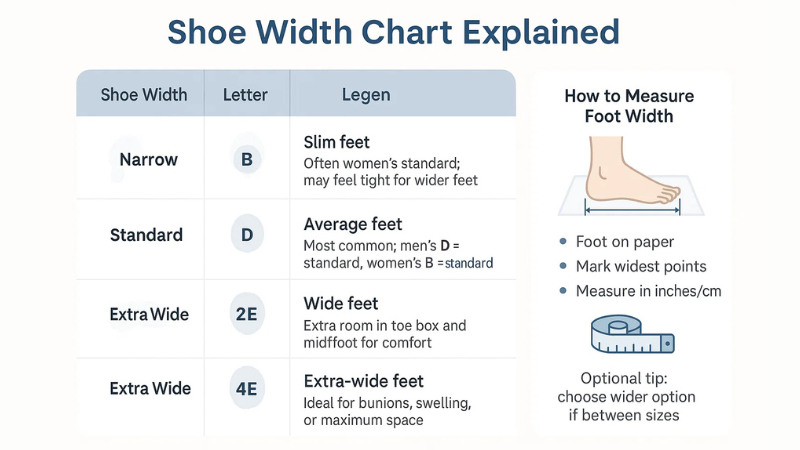
How to Measure Your Foot Width
Accurate measurement ensures you choose the correct shoe width:
- Place your foot flat on a sheet of paper.
- Mark the widest points across your forefoot (usually around the ball of your foot).
- Measure the distance in inches or centimeters.
Compare your measurement with the width chart provided by the shoe brand. Keep in mind that width sizing can slightly vary between brands, so always check brand-specific charts when shopping.
Pro Tip:
If your measurement falls between two widths, it’s generally better to choose the wider option for comfort, especially for long hours of standing or walking.
For men with narrower feet or women trying men’s shoes, consider insoles or heel grips to improve fit.
4. Why Width Matters for Foot Health
Wearing the correct shoe width is essential not just for comfort, but for preventing long-term foot problems and improving overall posture and mobility.
Shoes that are too narrow can squeeze the toes, increase friction, and place excessive pressure on the forefoot. Over time, this can lead to pain, blisters, calluses, or serious deformities like bunions and hammertoes.
On the other hand, shoes that are too wide may cause your foot to slide inside the shoe, reducing stability and increasing the risk of ankle sprains or fatigue.
Properly fitting wide shoes (EE/2E) allow the foot to spread naturally, promoting better balance and reducing strain on muscles and joints.
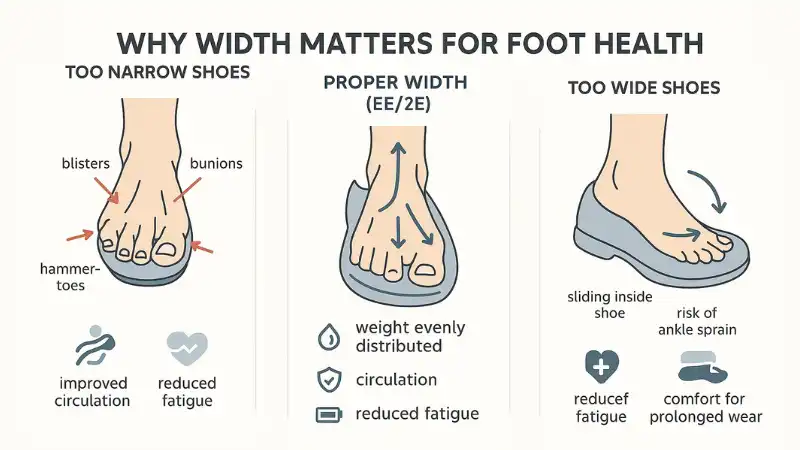
Additional benefits of wearing the correct width include:
- Improved circulation:
Less pressure on the toes and forefoot prevents numbness and swelling, which is especially important during long periods of standing or walking.
- Reduced fatigue:
Correct width distributes weight evenly, decreasing stress on the feet, ankles, knees, and lower back.
- Enhanced comfort for prolonged wear:
Nurses, healthcare workers, and runners spend hours on their feet, making proper width essential for preventing pain and maintaining performance.
- Injury prevention:
Properly fitting shoes reduce the likelihood of blisters, calluses, stress fractures, and other overuse injuries.
For anyone on their feet all day, investing in shoes with the right width is not optional — it’s a vital step toward foot health, comfort, and long-term mobility.
5. How to Know if You Need Wide Fit Shoes
Not all feet are the same shape or width, and wearing shoes that are too narrow can lead to discomfort, pain, or even long-term foot issues. Here’s how to determine if you might need wide-fit shoes (EE / 2E):
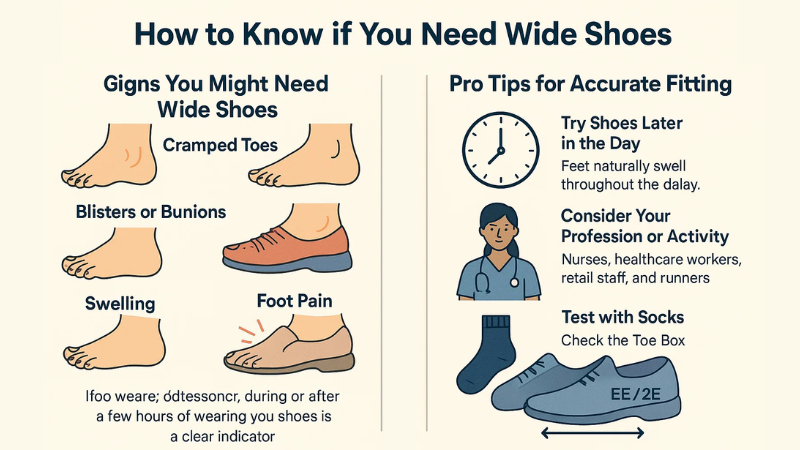
Signs You Might Need Wide Shoes
- Cramped Toes:
Your toes feel squeezed or bent when wearing standard-width shoes.
- Blisters or Bunions:
Frequent irritation or pressure on the sides of your feet.
- Swelling:
Feet expand during long shifts, extended walking, or running, making standard shoes feel tight.
- Foot Pain:
Discomfort during or after a few hours of wearing your shoes is a clear indicator.
Pro Tips for Accurate Fitting
- Try Shoes Later in the Day:
Feet naturally swell throughout the day. Testing shoes in the afternoon or evening ensures a more realistic fit.
- Consider Your Profession or Activity:
Nurses, healthcare workers, retail staff, and runners often need extra width to prevent pain from long hours of standing or walking.
- Test with Socks:
If you wear thick socks or compression socks, factor that into your fit. A wide shoe prevents squeezing when adding layers.
- Check the Toe Box:
There should be enough space for toes to wiggle slightly without rubbing against the front of the shoe.
By paying attention to these signs, you can select shoes that provide comfort, stability, and long-term foot health, rather than squeezing into standard widths that may cause problems.
Tips for Buying EE Shoes (Extra Wide Fit)
Finding the right EE or 2E shoes ensures comfort, prevents foot pain, and supports long hours of standing or walking. Whether you’re a nurse, healthcare worker, runner, or someone with naturally wide feet, these tips will help you select the perfect pair.
1. Measure Your Feet Accurately
Accurate measurement is crucial for a proper fit:
- Use a ruler, measuring tape, or a Brannock device to measure length and width.
- Measure both feet, as one foot is often slightly larger.
- Measure in the afternoon or evening, when feet are slightly swollen, to avoid underestimating width.
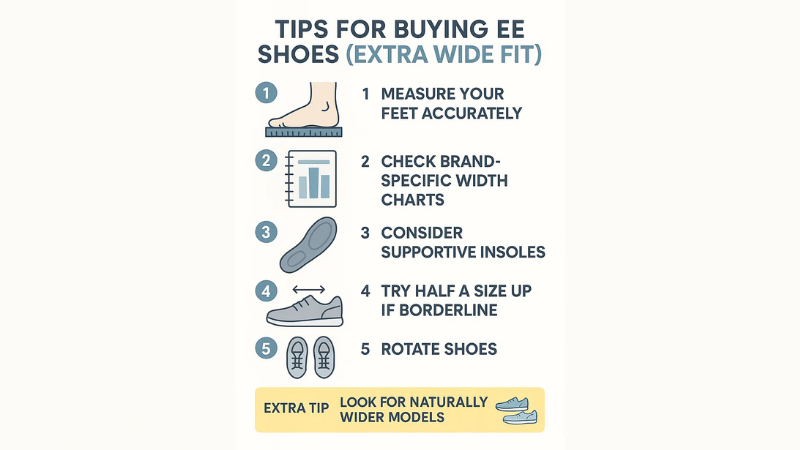
2. Check Brand-Specific Width Charts
Sizes and width labels differ between brands:
A D-width in one brand might feel narrower than a D in another.
- Always review the brand’s official EE width sizing chart to ensure consistency.
- Pay attention to comments in customer reviews regarding fit — some shoes may run wide or narrow despite the label.
3. Consider Supportive Insoles
Even wide shoes can benefit from additional cushioning:
- Insoles provide extra arch support and heel stability, reducing fatigue during long hours.
- Look for removable insoles, which allow customization and cleaning.
- For nurses or workers on their feet all day, shock-absorbing insoles can prevent foot, knee, and lower back pain.
4. Try Half a Size Up if Borderline
If your feet are between standard (D) and wide (EE):
- Opt for a half-size larger to accommodate width comfortably.
- This extra room prevents toes from rubbing against the front of the shoe and reduces risk of blisters or bunions.
5. Rotate Shoes
Rotating two or more pairs extends the life of your shoes and maintains comfort:
- Allow shoes to air out and recover between uses, especially if worn for long shifts or running.
- Rotating also prevents uneven wear and keeps cushioning functional for longer.
Extra Tip: Look for Naturally Wider Models
Some running shoes, walking shoes, and work shoes are built with wider toe boxes and midfoot areas:
- Check online reviews and product descriptions for width feedback before buying.
- Brands like New Balance, Brooks, Skechers, and Dansko often have wide or extra-wide options designed for comfort over long periods.
- By following these tips, you can confidently purchase EE shoes that support your feet, improve posture, and reduce discomfort — whether for work, exercise, or daily life.
Conclusion
Choosing the correct shoe width is just as important as selecting the right length. EE shoes provide extra space for wide feet, bunions, and swollen feet, ensuring comfort, better posture, and reduced risk of foot problems. Always measure your feet, check brand-specific charts, and consider supportive insoles for maximum comfort.
FAQs: What Does EE Mean in Shoe Size?
What does EE mean in shoe sizing for men and women?
A: EE indicates extra-wide shoes suitable for wider feet or foot conditions. Men and women may use slightly different labels, but EE is widely recognized.
Is 2E the same as EE?
A: Yes. 2E and EE are used interchangeably by most brands.
Are EE shoes wider than D or standard sizes?
A: Yes, EE provides more room in the toe box, midfoot, and arch.
Can wearing the wrong width shoes cause foot problems?
A: Absolutely. Wearing narrow shoes can lead to blisters, bunions, and long-term foot pain.
How do I measure my foot width at home?
A: Use a ruler to measure the widest part of your foot and compare it with a shoe width chart.

Leave a Reply